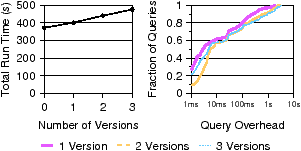
Spyglass: Fast, Scalable Metadata Search for Large-Scale Storage Systems
| Andrew W. Leung⋆ | Minglong Shao† | Timothy Bisson† | Shankar Pasupathy† | Ethan L. Miller⋆ |
| ⋆University of California, Santa Cruz | †NetApp |
| {aleung, elm}@cs.ucsc.edu | {minglong, tbisson, shankarp}@netapp.com |
|
Abstract: The
scale of today’s storage systems has made it increasingly
difficult to find and manage files. To address this, we have developed
Spyglass, a file metadata search system that is specially designed
for large-scale storage systems. Using an optimized design, guided by
an analysis of real-world metadata traces and a user study, Spyglass
allows fast, complex searches over file metadata to help users and
administrators better understand and manage their files.
Spyglass
achieves fast, scalable performance through the use of
several novel metadata search techniques that exploit metadata search
properties. Flexible index control is provided by an index
partitioning mechanism that leverages namespace locality. Signature
files are used to significantly reduce a query’s search space,
improving performance and scalability. Snapshot-based metadata
collection allows incremental crawling of only modified files. A novel
index versioning mechanism provides both fast index updates and
“back-in-time” search of metadata. An evaluation of our Spyglass
prototype using our real-world, large-scale metadata traces shows
search performance that is 1-4 orders of magnitude faster than
existing solutions. The Spyglass index can quickly be updated and
typically requires less than 0.1% of disk space. Additionally,
metadata collection is up to 10× faster than existing
approaches.
1 Introduction
The rapidly growing amounts of data in today’s storage systems makes
finding and managing files extremely difficult. Storage users and
administrators need to efficiently answer questions about the
properties of the files being stored in order to properly manage this
increasingly large sea of data. Metadata search, which involves
indexing file metadata such as inode fields and extended attributes,
can help answer many of these
questions [26]. Metadata search allows point, range,
top-k, and aggregation search over file properties, facilitating
complex, ad hoc queries about the files being stored. For example, it
can help an administrator answer “which files can be moved to second
tier storage?” or “which application’s and user’s files are
consuming the most space?”. Metadata search can also help a user find
his or her ten most recently accessed presentations or largest virtual
machine images. Efficiently answering these questions can greatly
improve how user and administrator manage files in large-scale storage
systems.
Unfortunately, fast and efficient metadata search in large-scale
storage systems is difficult to achieve. Both customer
discussions [37] and personal experience have shown
that existing enterprise search tools that provide metadata
search [14, 17, 21, 30, 4]
are often too expensive, slow, and cumbersome to be effective in
large-scale systems. Effective metadata search must meet
several requirements. First, it must be able to quickly gather
metadata from the storage system. We have observed commercial systems
that took 22 hours to crawl 500 GB and 10 days to crawl 10 TB.
Second, search and update must be fast and scalable. Existing systems
typically index metadata in a general-purpose DBMS. However, DBMSs are
not a perfect fit for metadata search, which can limit their
performance and scalability in large-scale systems. Third, resource
requirements must be low. Existing tools require dedicated CPU,
memory, and disk hardware, making them expensive and difficult to
integrate into the storage system. Fourth, the search interface must
be flexible and easy to use. Metadata search enables complex file
searches that are difficult to ask with existing file system
interfaces and query languages. Fifth, search results must be secure;
many existing systems either ignore file ACLs or significantly degrade
performance to enforce them.
To address these issues, we developed Spyglass, a novel metadata
search system that exploits file metadata properties to enable fast,
scalable search that can be embedded within the storage system. To
guide our design, we collected and analyzed file metadata snapshots
from real-world storage systems at NetApp and conducted a survey of
over 30 users and IT administrators. Our design introduces several new
metadata search techniques. Hierarchical partitioning is a new
method of namespace-based index partitioning that exploits namespace
locality to provide flexible control of the index. Signature
files are used to compactly describe a partition’s contents, helping
to route queries only to relevant partitions and prune the search
space to improve performance and scalability. A new
snapshot-based metadata collection method provides scalable
collection by re-crawling only the files that have changed. Finally,
partition versioning, a novel index versioning mechanism,
enables fast update performance while allowing “back-in-time” search
of past metadata. Spyglass does not currently address search
interface or security, which are left to future work.
An evaluation of our Spyglass prototype, using our real-world,
large-scale metadata traces, shows that search performance is improved
1–4 orders of magnitude compared to basic DBMS setups. Additionally,
search performance is scalable; it is capable of searching hundreds of
millions of files in less than a second. Index update performance is
up to 40× faster than basic DBMS setups and scales linearly
with system size. The index itself typically requires less than 0.1%
of total disk space. Index versioning allows “back-in-time” metadata
search while adding only a tiny overhead to most queries. Finally, our
snapshot-based metadata collection mechanism performs 10×
faster than a straw-man approach. Our evaluation demonstrates that
Spyglass can leverage file metadata properties to improve how files
are managed in large-scale storage systems.
This remainder of this paper is organized as follows.
Section 2 provides additional metadata search
motivation and background. Section 3 presents the
Spyglass design. Our prototype is evaluated in
Section 4. Related work is discussed in
Section 5, with future work and conclusions in
Section 6.
2 Background
This section describes and motivates the use of file metadata search
and includes a discussion of real-world query and metadata
characteristics.
2.1 File Metadata
File metadata, such as inode fields (e.g., size, owner, timestamps etc.),
generated by the storage system and extended attributes (e.g., document
title, retention policy, backup dates, etc.), generated by users and
applications, is typically represented as ⟨
attribute,value ⟩ pairs that describe file
properties. Today’s storage systems can contain millions to billions
of files, and each file can have dozens of metadata attribute-value
pairs, resulting in a data set with 1010−1011 total pairs.
The ability to search file metadata facilitates complex queries on the
properties of files in the storage system, helping administrators
understand the kinds of files being stored, where they are located,
how they are used, how they got there (provenance), and where they
should belong. For example, finding which files to migrate to tape may
involve searching file size, access time, and owner metadata
attributes, allowing administrators to decide on and enforce their
management policies. Metadata search also helps users locate misplaced
files, manage their storage space, and track file changes. As a
result, metadata search tools are becoming more prevalent; recent
reports state that 37% of enterprise businesses use such tools and
40% plan to do so in the near future [12].
| File Management Question | Metadata Search Query |
| Which files can I migrate to tape? | size > 50 GB, atime > 6 months. |
| How many duplicates of this file are in my home directory? | owner = john, datahash = 0xE431, path = /home/john. |
| Where are my recently modified presentations? | owner = john, type = (ppt ∣ keynote), mtime < 2 days. |
| Which legal compliance files can be expired? | retention time = expired, mtime > 7 years |
| Which of my files grew the most in the past week? | Top 100 where size(today) > size(1 week ago), owner = john. |
| How much storage do these users and applications consume? | Sum size where owner = john, type = database |
| Table 1: Use case examples. Metadata search use cases
collected from our user survey. The high-level questions being
addressed are on the left. On the right are the metadata attributes
being searched and example values. Users used basic inode metadata,
as well as specialized extended attributes, such as legal retention
times. Common search characteristics include multiple attributes,
localization to part of the namespace, and “back-in-time” search. |
To better understand metadata search needs, we surveyed over 30
large scale storage system users and administrators. We found subjects
using metadata search for a wide variety of purposes. Use cases
included managing storage tiers, tracking legal compliance data,
searching large scientific data output files, finding files with
incorrect security ACLs, and resource/capacity planning.
Table 1 provides examples of some popular use cases
and the metadata attributes searched.
2.2 Efficient Metadata Search
Providing efficient metadata search in large-scale storage systems is
a challenge. While a number of commercial file metadata search
systems exist
today [14, 17, 21, 30, 4],
these systems focus on smaller scales (e.g., up to tens of millions of
files) and are often too slow, resource intensive, and expensive to be
effective for large-scale systems. To be effective at large scales,
file metadata search must provide the following:
1) Minimal resource requirements. Metadata search
should not require additional hardware. It should be embedded within
the storage system and close to the files it indexes while not
degrading system performance. Most existing systems require dedicated
CPU, memory, and disk hardware, making them expensive and hard to
deploy, and limiting their scalability.
2) Fast metadata collection. Metadata changes must
be periodically collected from millions to billions of files without
exhausting or slowing the storage system. Existing crawling methods
are slow and can tax system resources. Hooks to notify systems of
file changes can add overhead to important data paths.
3) Fast and scalable index search and update.
Searches must be fast, even as the system grows, or usability may
suffer. Updates must allow fast periodic re-indexing of metadata.
However, existing systems typically rely on general-purpose relational
databases (DBMSs) to index metadata. For example, Microsoft’s
enterprise search indexes metadata in their Extensible Storage Engine
(ESE) database [30]. Unfortunately, DBMSs often
use heavyweight locking and transactions that add overhead even when
disabled [43]. Additionally, their designs make
significant trade-offs between search and update
performance [1]. DBMSs also assume abundant CPU,
memory, and disk resources. Although standard DBMSs have benefited from
decades of performance research and optimizations, such as vertical
partitioning [23] and materialized views, their
designs are not a perfect fit for metadata search. This is not a new
concept; the DBMS community has argued that general-purpose DBMSs are
not a “one size fits all
solution” [9, 42, 43],
instead saying that application-specific designs are often best.
4) Easy to use search interface. Most systems
export simple search APIs. However, recent
research [3] has shown that specially designed
interfaces that can provide an expressive and easy to use query
capabilities can greatly improve search experience.
5) Secure search results. Search results must not
allow users to find or access restricted files [10].
Existing systems either ignore security or enforce it at a significant
cost to performance.
We designed Spyglass to address these challenges in large-scale
storage systems. Spyglass is specially designed to exploit metadata
search properties to achieve scale and performance while being
embedded within the storage system. Spyglass focuses on crawling,
updating, and searching metadata; interface and security designs are
left to future work.
2.3 Metadata Search Properties
To understand metadata search properties, we analyzed results from our
user survey and real-world metadata snapshot traces collected from
storage servers at NetApp. We then used this analysis to guide our
Spyglass design.
Search Characteristics. From our survey, we
observed three important metadata search characteristics. First, over
95% of searches included multiple metadata attributes to
refine search results; a search on a single attribute over a large
file system can return thousands or even millions of results, which
users do not want to sift through. Second, about 33% of
searches were localized to part of the namespace, such as a
home or project directory. Users often have some idea of where their
files are and a strong idea of where they are not; localizing the
search focuses results on only relevant parts of the namespace.
Third, about 25% of the searches that users deemed most important
searched multiple versions of metadata. Users use
“back-in-time” searches to understand file trends and how files are
accessed.
| Data Set | Description | # of Files | Capacity |
| Web | web & wiki server | 15 million | 1.28 TB |
| Eng | build space | 60 million | 30 GB |
| ~ | home directories | 300 million | 76.78 TB |
| Table 2: Metadata traces collected. The small server
capacity of the
Eng trace is due to the majority of the files being small source
code files: 99% of files are less than 1 KB. |
| Attribute | Description | Attribute | Description |
| inumber | inode number | owner | file owner |
| path | full path name | size | file size |
| ext | file extension | ctime | change time |
| type | file or directory | atime | access time |
| mtime | modification time | hlink | hard link # |
| Table 3: Attributes used. We analyzed the fields in the
inode structure and extracted ext values from path. |
Metadata Characteristics.
We collected metadata snapshot traces from three storage servers at
NetApp. Our traces—Web, Eng, and ~-–are described in
Table 2. Table 3 describes the
metadata attributes that we analyzed. NetApp servers support
extended attributes, though they were rarely used in these traces. We
found two key properties in these traces: metadata has spatial
locality and highly skewed distributions of values.
[
Locality Ratio=54%]

[
Locality Ratio=38%]

| Figure 1: Examples of locality ratio. Directories that recursively
contain the ext attribute value html are black and gray. The
black directories contain the value.
The locality ratio of ext value
html is 54% (=7/13) in the first tree and 38% (=5/13) in the
second tree. The value of html has better spatial
locality in the second tree than in the first one. |
Spatial locality means that attribute values are clustered in the
namespace (i.e., occurring in relatively few directories). For example,
john’s files reside mostly in the /home/john
sub-tree, not scattered evenly across the
namespace. Spatial locality comes from the way that users and applications
organize files in the namespace, and has been noted in other file
system studies [2, 25]. To measure
spatial locality, we use an attribute value’s locality ratio:
the percent of directories that recursively contain the value,
as illustrated in Figure 1.
A directory recursively contains an
attribute value if it or any of its sub-directories contains the
value. The figure on the right has a lower locality ratio because the
ext attribute value html is recursively contained in fewer
directories. Table 4 shows the locality ratios for
the 32 most frequently occurring values for various attributes (ext,
size, owner, ctime, mtime) in each trace. Locality ratios are less than
1% for all attributes, meaning that 99% of directories do not
recursively contain the value. We expect extended attributes to
exhibit similar properties since they are often tied to file type and
owner attributes.
Utilizing spatial locality can help prune a query’s search space by
identifying only the parts of the namespace that contain a metadata
value, eliminating a large number of files to search. Unfortunately,
most general-purpose DBMSs treat path names as flat string attributes,
making it difficult for them to utilize this information, instead
typically requiring them to consider all files for a search no
matter its locality.
| | ext | size | uid | ctime | mtime |
| Web | 0.000162% – 0.120% | 0.0579% – 0.177% | 0.000194% – 0.0558% | 0.000291% – 0.0105% | 0.000388% – 0.00720% |
| Eng | 0.00101% – 0.264% | 0.00194% – 0.462% | 0.000578% – 0.137% | 0.000453% – 0.0103% | 0.000528% – 0.0578% |
| ~ | 0.000201% – 0.491% | 0.0259% – 0.923% | 0.000417% – 0.623% | 0.000370% – 0.128% | 0.000911% – 0.0103% |
| Table 4: Locality ratios of the 32 most frequently occurring
attribute values. All locality ratios are well below 1%, which
means that files with these attribute values are recursively contained
in less than 1% of directories. |
Metadata values also have highly skewed frequencies—their popularity
distributions are asymmetric, causing a few very popular metadata
values to account for a large fraction of all total values. This
distribution has also been observed in other metadata
studies [2, 11].
Figures 2(a) and 2(b) show the
distribution of ext and size values from our ~trace on a
log-log scale. The linear appearance indicates that the distributions are
Zipf-like and follow the power law
distribution [40]. In these distributions, 80%
of files have one of the 20 most popular ext or size values, while
the remaining 20% of the files have thousands of other values.
Figure 2(c) shows the distribution of the Cartesian
product (i.e., the intersection) of the top 20 ext and size values.
The curve is much flatter, which indicates a more even distribution of
values. Only 33% of files have one of the top 20 ext and size combinations. In Figure 2(c), file percentages for
corresponding ranks are at least an order of magnitude lower than in
the other two graphs. This means, for example, that there are many
files with owner john and many files with ext pdf, but there are often over an order of magnitude fewer
files with both owner john and ext pdf.
These distribution properties show that multi-attribute searches will
significantly reduce the number of query results. Unfortunately, most
DBMSs rely on attribute value distributions (also known as
selectivity) to choose a query plan. When distributions are skewed,
query plans often require extra data processing [28];
for example, they may retrieve all of john’s files to find
the few that are john’s pdf files or
vice-versa. Our analysis shows that query execution should utilize
attribute values’ spatial locality rather than their frequency
distributions. Spatial locality provides a more effective way to
execute a query because it is more selective and can better reduce a
query’s search space.
[]
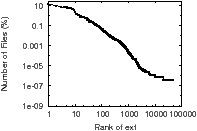
[]
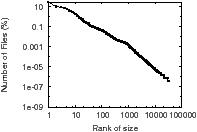
[]
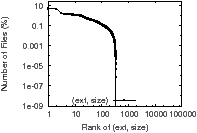
| Figure 2: Attribute value distribution examples. A rank of 1
represents the attribute value with the highest file count. The linear
curves on the log-log scales in Figures 2(a)
and 2(b) indicate a Zipf-like distribution, while
the flatter curve in Figure 2(c) indicates a
more even distribution. |
3 Spyglass Design
| Figure 3: Spyglass overview. Spyglass resides within the
storage system. The crawler extracts file metadata, which gets stored
in the index. The index consists of a number of partitions and
versions, all of which are managed by a caching system. |
Spyglass uses several novel techniques that exploit the metadata
search properties discussed in Section 2 to provide
fast, scalable search in large-scale storage systems. First,
hierarchical partitioning partitions the index based on the
namespace, preserving spatial locality in the index and allowing
fine-grained index control. Second, signature
files [13] are used improve search performance by
leveraging locality to identify only the partitions that are relevant
to a query. Third, partition versioning versions index updates,
which improves update performance and allows “back-in-time” search
of past metadata versions. Finally, Spyglass utilizes storage
systems snapshots to crawl only the files whose metadata has changed,
providing fast collection of metadata changes. Spyglass resides within
the storage system and consists of two major components, shown in
Figure 3: the Spyglass index, which stores metadata
and serves queries, and a crawler that extracts metadata from the
storage system.
3.1 Hierarchical Partitioning
To exploit metadata locality
and improve scalability, the Spyglass index is partitioned into a
collection of separate, smaller indexes,
which we call hierarchical partitioning. Hierarchical partitioning is
based
on the storage system’s namespace and encapsulates separate parts of
the
namespace into separate partitions, thus allowing more flexible, finer
grained control of the index. Similar partitioning strategies are often
used by file systems to distribute the namespace across multiple
machines [35, 44].
Each of the Spyglass partitions is stored sequentially on disk, as
shown in Figure 4. Thus, unlike a DBMS, which
stores records adjacently on disk using their row or column order,
Spyglass groups records nearby in the namespace together on disk.
This approach improves performance since the files that satisfy a
query are often clustered in only a portion of the namespace, as shown
by our observations in Section 2. For example, a
search of the storage system for john’s .ppt
files likely does not require searching sub-trees such as other user’s
home directories or system file directories. Hierarchical
partitioning allows only the sub-trees relevant to a search to be
considered, thereby enabling reduction of the search space and
improving scalability. Also, a user may choose to localize the search
to only a portion of the namespace. Hierarchical partitioning allows
users to control the scope of the files that are searched. A
DBMS-based solution usually encodes pathnames as flat strings, making
it oblivious to the hierarchical nature of file organization and
requiring it to consider the entire namespace for each search. If the
DBMS stores the files sorted by file name, it can improve locality and
reduce the fraction of the index table that must be scanned; however,
this approach can still result in performance problems for index
updates, and does not encapsulate the hierarchical relationship
between files.
Spyglass partitions are kept small, on the order of 100,000 files, to
maintain locality in the partition and to ensure that each can be read
and searched very quickly. Since partitions are stored sequentially
on disk, searches can usually be satisfied with only a few small
sequential disk reads. Also, sub-trees often grow at a slower rate
than the system as a whole [2, 25], which
provides scalability because the number of partitions to search will
often grow slower than the size of the system.
| Figure 4: Hierarchical partitioning example. Sub-tree
partitions, shown in different colors, index different storage system
sub-trees. Each partition is stored sequentially on disk. The
Spyglass index is a tree of sub-tree partitions. |
We refer to each partition as a sub-tree partition; the
Spyglass index is a tree of sub-tree partitions that reflects the
hierarchical ordering of the storage namespace. Each partition has a
main partition index, in which file metadata for the partition
is stored; partition metadata, which keeps information about
the partition; and pointers to child partitions. Partition metadata
includes information used to determine if a partition is relevant to a
search and information used to support partition versioning.
The Spyglass index is stored persistently on disk; however, all
partition metadata, which is small, is cached in-memory. A partition
cache manages the movement of entire partition indexes to and from
disk as needed. When a file is accessed, its neighbor files will
likely need to be accessed as well, due to spatial locality. Paging
entire partition indexes allows metadata for all of these files to be
fetched in a single, small sequential read. This concept is similar
to the use of embedded inodes [15], to store inodes
adjacent to their parent directory on disk.
In general, Spyglass search performance is a function of the number
of partitions that must be read from disk. Thus, the partition cache’s
goal is to reduce disk accesses by ensuring that most partitions
searched are already in-memory. While we know of no studies of file
system query patterns we believe that a simple LRU algorithm is
effective. Both web queries [5] and file system
access patterns [25] exhibit skewed, Zipf-like
popularity distributions, suggesting that file metadata queries
may exhibit similar popularity distributions; this would mean
that only a small subset of partitions will be frequently accessed. An
LRU algorithm keeps frequently accessed partitions in-memory, ensuring
high performance for common queries and efficient cache utilization.
Partition Indexes. Each partition index must
provide fast, multi-dimensional search of the metadata it indexes. To
do this we use a K-D tree [7], which is a
k-dimensional binary tree, because it provides lightweight,
logarithmic point, range, and nearest neighbor search over k
dimensions and allows multi-dimensional search of a partition in tens
to hundreds of microseconds. However, other index structures can
provide additional functionality. For example,
FastBit [45] provides high index compression, Berkeley
DB [34] provides transactional storage,
cache-oblivious B-trees [6] improve update time, and
K-D-B-trees [38] allow partially in-memory
K-D trees. However, in most cases, the fast, lightweight nature of
K-D trees is preferred. The drawback to K-D trees is that they are
difficult to update; Section 3.2 describes
techniques to avoid continuous updates.
Partition Metadata. Partition metadata contains
information about the files in the partition, including paths of
indexed sub-trees, file statistics, signature files, and version
information. File statistics, such as file counts and minimum and
maximum values, are kept to answer aggregation and trend queries
without having to process the entire partition index. These statistics
are computed as files are being indexed. A version vector,
which is described in Section 3.2, manages
partition versions. Signature files are used to determine if the
partition contains files relevant to a query.
Signature files [13] are bit arrays that serve as
compact summaries of a partition’s contents and exploit metadata
locality to prune a query’s search space. A common example of a
signature file is the Bloom Filter [8]. Spyglass can
determine whether a partition may index any files that match a
query simply by testing bits in the signature files. A signature file
and an associated hashing function are created for each attribute
indexed in the partition. All bits in the signature file are
initially set to zero. As files are indexed, their attribute values
are hashed to a bit position in the attribute’s signature file, which
is set to one. To determine if the partition indexes files relevant to
a query, each attribute value being searched is hashed and its bit
position is tested. The partition needs to be searched only if
all bits tested are set to one. Due to spatial locality, most
searches can eliminate many partitions, reducing the number of disk
accesses and processing a query must perform.
Due to collisions in the hashing function that cause false positives,
a signature file determines only if a partition may contain
files relevant to a query, potentially causing a partition to be
searched when it does not contain any files relevant to a search.
However, signature files cannot produce false negatives, so partitions
with relevant files will never be missed. False-positive rates can be
reduced by varying the size of the signature or changing the hashing
function. Increasing signature file sizes, which are initially around
2 KB, decreases the chances of a collision by increasing the total
number of bits. This trades off increased memory requirements and
lower false positive rates. Changing the hashing function allow a
bit’s meaning and how it is used to be improved. For example, consider
a signature file for file size attributes. Rather than have each bit
represent a single size value (e.g., 522 bytes), we can reduce false
positives for common small files by mapping each 1 KB range to a
single bit for sizes under 1 MB. The ranges for less common large
files can be made more coarse, perhaps using a single bit for sizes
between 25 and 50 MB.
The number of signature files that have to be tested can be reduced by
utilizing the tree structure of the Spyglass index to create
hierarchically defined signature files. Hierarchical signature files
are smaller signatures (roughly 100 bytes) that summarize the
contents of its partition and the partitions below it in the tree.
Hierarchical signature files are the logical OR of a partition’s
signature files and the signature files of its children. A single
failed test of a hierarchical signature file can eliminate huge parts
of the index from the search space, preventing every partition’s
signature files from being tested. Hierarchical signature files are
kept small to save memory at the cost of increased false positives.
3.2 Partition Versioning
Spyglass improves update performance and enables “back-in-time”
search using a technique called partition versioning that batches
index updates, treating each batch as a new incremental index
version. The motivation for partition versioning is two-fold. First,
we wish to improve index update performance by not having to modify
existing index structures. In-place modification of existing indexes
can generate large numbers of disk seeks and can cause partition index
structures to become unbalanced. Second, back-in-time search can help
answer many important storage management questions that can track file
trends and how they change.
Spyglass batches updates before they are applied as new versions to
the index, meaning that the index may be stale because file modifications
are not immediately reflected in the index. However, batching updates
improves index update performance by eliminating many small, random,
and frequent updates that can thrash the index and
cache. Additionally, from our user survey, most queries can be
satisfied with a slightly stale index. It should be noted that
partition versioning does not require updates to be batched. The index
can be updated in real time by versioning each individual file
modification, as is done in most versioning file
systems [39, 41].
| Figure 5: Versioning partitioning example.
Each sub-tree partition manages its own versions. A baseline
index is a normal partition index from some initial time T0.
Each incremental index contains the changes required to roll
query result forward to a new point in time. Each sub-tree partition
manages its version in a version vector. |
Creating Versions. Spyglass versions each sub-tree
partition individually rather than the entire index as a whole in
order to maintain locality. A versioned sub-tree partition consists
of two components: a baseline index and incremental
indexes, which are illustrated in Figure 5. A
baseline index is a normal partition index that represents the state
of the storage system at time T0, or the time of the initial
update. An incremental index is an index of metadata changes
between two points in time Tn−1 and Tn. These changes are
indexed in K-D trees, and smaller signature files are created for each
incremental index. Storing changes differs from the approach used in
some versioning file systems [39], which maintain full
copies for each version. Changes consist of metadata creations,
deletions, and modifications. Maintaining only changes requires a
minimal amount of storage overhead, resulting in a smaller footprint
and less data to read from disk.
Each sub-tree partition starts with a baseline index, as shown in
Figure 5. When a batch of metadata changes is
received at T1, it is used to build incremental indexes. Each
partition manages its incremental indexes using a version
vector, similar in concept to inode logs in the Elephant File
System [39]. Since file metadata in different parts
of the file system change at different
rates [2, 25], partitions may have
different numbers and sizes of incremental indexes. Incremental
indexes are stored sequentially on disk adjacent to their
baseline index. As a result, updates are fast because each partition
writes its changes in a single, sequential disk access. Incremental
indexes are paged into memory whenever the baseline index is accessed,
increasing the amount of data that must be read when paging in a
partition, though not typically increasing the number of disk
seeks. As a result, the overhead of versioning on overall search
performance is usually small.
Performing a “back-in-time” search that is accurate as of time Tn
works as follows. First, the baseline index is searched, producing
query results that are accurate as of T0. The incremental indexes
T1 through Tn are then searched in chronological order. Each
incremental index searched produces metadata changes that modify the
search results, rolling them forward in time, and eventually
generating results that are accurate as of Tn. For example,
consider a query for files with owner john that matches
two files, Fa and Fb, at T0. A search of incremental indexes
at T1 may yield changes that cause Fb to no longer match the
query (e.g., no longer owned by john), and a later search of
incremental indexes at Tn may yield changes that cause file Fc
to match the query (i.e., now owned by john). The results of
the query are Fa and Fc, which is accurate as of Tn. Because
this process is done in memory and each version is relatively small,
searching through incremental indexes is often very fast. In rolling
results forward, a small penalty is paid to search the most recent
changes; however, updates are much faster because no data needs to be
copied, as is the case in CVFS [41], which rolls
version changes backwards rather than forwards.
Managing Versions. Over time, older versions tends
to decrease in value and should be removed to reduce search overhead
and save space. Spyglass provides two efficient techniques for
managing partition versions: version collapsing and
version checkpointing. Version collapsing applies each
partition’s incremental index changes to its baseline index. The
result is a single baseline for each partition that is accurate as of
the most recent incremental index. Collapsing is efficient because all
original index data is read sequentially and the new baseline is
written sequentially. Version checkpointing allows an index
to be saved to disk as a new copy to preserve an important landmark version of
the index.
We describe how collapsing and checkpointing can be used with an
example. During the day, Spyglass is updated hourly, creating new
versions every hour, thus allowing “back-in-time” searches to be
performed at per-hour granularity over the day. At the end of each
day, incremental versions are collapsed, reducing space
overhead at the cost of prohibiting hour-by-hour searching over the
last day. Also, at the end of each day, a copy of the collapsed index
is checkpointed to disk, representing the storage system state at the
end of each day. At the end of each week, all but the latest daily
checkpoints are deleted; and at the end of each month, all but the
latest weekly checkpoints are deleted. This results in versions of
varying time scales. For example, over the past day any hour can be
searched, over the past week any day can be searched, and over the
past month any week can be searched. The frequency for index
collapsing and checkpointing can be configured based on user needs and
space constraints.
3.3 Collecting Metadata Changes
The Spyglass crawler takes advantage of NetApp®
Snapshot™ technology in the NetApp WAFL ®
file system [19] on which it was
developed to quickly collect metadata changes. Given two snapshots,
Tn−1 and Tn, Spyglass calculates the difference between
them. This difference represents all of the file metadata changes
between Tn−1 and Tn. Because of the way snapshots are created,
only the metadata of changed files is re-crawled.
| Figure 6: Snapshot-based metadata collection. In snapshot
2, block 7 has changed since snapshot 1. This change is propagated up
the tree. Because block 2 has not changed, we do not need to examine
it or any blocks below it. |
All metadata in WAFL resides in a single file called the inode
file, which is a collection of fixed length inodes. Extended
attributes are included in the inodes. Performing an initial crawl of
the storage system is fast because it simply involves sequentially
reading the inode file. Snapshots are created by making a
copy-on-write clone of the inode file. Calculating the difference
between two snapshots leverages this mechanism. This is shown in
Figure 6. By looking at the block numbers of the
inode file’s indirect and data blocks, we can determine exactly which
blocks have changed. If a block’s number has not changed, then it does
not need to be crawled. If this block is an indirect block, then no
blocks that it points to need to be crawled either because block changes
will propagate all the way back up to the inode file’s root block. As
a result, the Spyglass crawler can identify just the data blocks that
have changed and crawl only their data. This approach greatly enhances
scalability because crawl performance is a function of the number of
files that have changed rather than the total number of files.
Spyglass is not dependent on snapshot-based crawling, though it
provides benefits compared to alternative approaches. Periodically
walking the file system can be extremely slow because each file must
be traversed. Moreover, traversal can utilize significant system
resources and alter file access times on which file caches depend.
Another approach, file system event notifications (e. g.,
inotify [22]), requires hooks into critical
code paths, potentially impacting performance. A changelog, such as
the one used in NTFS, is another alternative; however, since we are not
interested in every system event, a snapshot-based scheme is more
efficient.
3.4 Distributed Design
Our discussion thus far has focused on indexing and crawling on a
single storage server. However, large-scale storage systems are often
composed of tens or hundreds of servers. While we do not currently
address how to distribute the index, we believe that hierarchical
partitioning lends itself well to a distributed environment because
the Spyglass index is a tree of partitions. A distributed file system
with a single namespace can view Spyglass as a larger tree composed
of partitions placed on multiple servers. As a result, distributing
the index is a matter of effectively scaling the Spyglass index tree.
Also, the use of signature files may be effective at routing
distributed queries to relevant servers and their sub-trees.
Obviously, there are many challenges to actually implementing this. A
complete design is left to future work.
4 Experimental Evaluation
We evaluated our Spyglass prototype to determine how well our design
addresses the metadata search challenges described in
Section 2 for varying storage system sizes. To do
this, we first measured metadata collection speed, index update
performance, and disk space usage. We then analyzed search performance
and how effectively index locality is utilized. Finally, we measured
partition versioning overhead.
Implementation Details. Our Spyglass prototype
was implemented as a user-space process on Linux. An RPC-based
interface to WAFL gathers metadata changes using our snapshot-based
crawler. Our prototype dynamically partitions the index as it is being
updated. As files and directories are inserted into the index, they
are placed into the partition with the longest pathname match (i.e., the
pathname match farthest down the tree). New partitions are created
when a directory is inserted and all matching partitions are full. A
partition is considered full when it contains over 100,000 files. We
use 100,000 as the soft partition limit in order to ensure that
partitions are small enough to be efficiently read and written to
disk. Using a much smaller partition size will often increase the
number of partitions that must be accessed for a query; this incurs
extra expensive disk seeks. Using a much larger partition size
decreases the number of partitions that must be accessed for a query;
however it poorly encapsulates spatial locality, causing extra data to be
read from disk. In the case of symbolic and hard links, multiple index
entries are used for the file.
During the update process, partitions are buffered in-memory and
written sequentially to disk when full; each is stored in a separate
file. K-D trees were implemented using
libkdtree++ [27]. Signature file
bit-arrays are about 2 KB, but hierarchical signature files
are only 100 bytes, ensuring that signature files can fit within our
memory constraints. Hashing functions that allowed each signature
file’s bit to correspond to a range of values were used for file size
and time attributes to reduce false positive rates. When incremental
indexes are created, they are appended to their partition on
disk. Finally, we implement a simple search API that allows point,
range, top-k, and aggregation searches. We plan to extend this
interface as future work.
Experimental Setup. We evaluated performance using
our real-world metadata traces described in Table 2.
These traces have varying sizes, allowing us to examine
scalability. Our Web and Eng traces also have incremental snapshot
traces of daily metadata changes for several days. Since no standard
benchmarks exist, we constructed synthetic sets of queries, discussed
later in this section, from our metadata traces to evaluate search
performance. All experiments were performed on a dual core AMD
Opteron machine with 8 GB of main memory running Ubuntu
Linux 7.10. All index files were stored on a network partition that
accessed a high-end NetApp file server over NFS.
We
also evaluated the performance of two popular relational DBMSs,
PostgreSQL and MySQL, which serve as relative comparison points to
DBMS-based solutions used in other metadata search systems. The goal
of our comparison is to provide some context to frame our Spyglass
evaluation, not to compare performance to the best possible DBMS
setup. We compared Spyglass to an index-only DBMS setup, which is
used in several commercial metadata search systems, and also tuned
various options, such as page size, to the best of our ability. This
setup is effective at pointing out several basic DBMS performance
problems. DBMS performance can be improved through the
techniques discussed in Section 2; however, as
stated earlier, they do not completely match metadata search
cost and performance requirements.
Our Spyglass prototype indexes the metadata attributes listed in
Table 3. Our index-only DBMSs include a base
relation with the same metadata attributes and a B+-tree index for each. Each
B+-tree indexes table row ID. An index-only design reduces space usage
compared to some more advanced setups, though it has slower search
performance. In all three traces, cache sizes were configured to
128 MB, 512 MB, and 2.5 GB for the Web, Eng, and ~traces,
respectively. These sizes are small relative to the size of their
trace and correspond to about 1 MB for every 125,000 files.
[Baseline]
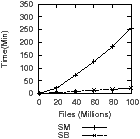 [Incremental: 2%, 5%, and 10% changes from baseline]
[Incremental: 2%, 5%, and 10% changes from baseline]
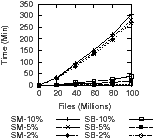
| Figure 7: Metadata collection performance. We compare
Spyglass’s snapshot-based crawler (SB) to a straw-man design (SM).
Our crawler has good scalability; performance is a function
of the number of changed files rather than system size. |
Metadata Collection Performance. We first
evaluated our snapshot-based metadata crawler and compared it to a
straw-man approach. Fast collection performance impacts how often
updates occur and system resource utilization. Our straw-man approach
performs a parallelized walk of the file system using stat()
to extract metadata. Figure 7(a) shows the performance
of a baseline crawl of all file metadata. Our snapshot based crawler
is up to 10× faster than our straw-man for 100 million files
because our approach simply scans the inode file. As a result, a
100 million file system is crawled in less than 20 minutes.
Figure 7(b) shows the time required to collect
incremental metadata changes. We examine systems with 2%, 5%, and
10% of their files changed. For example, a baseline of 40 million
files and 5% change has 2 million changed files. For the 100 million
file tests, each of our crawls finishes in under 45 minutes, while our
straw-man takes up to 5 hours. Our crawler is able to crawl the inode
file at about 70,000 files per second. Our crawler effectively scales
because we incur only a fractional overhead as more files are crawled;
this is due to our crawling only changed blocks of the inode file.
| Figure 8: Update performance. The time required to build an
initial baseline index shown on a log-scale. Spyglass updates
quickly and scales linearly because updates are written to disk mostly
sequentially. |
Update Performance. Figure 8
shows the time required to build the initial index for each of our
metadata traces. Spyglass requires about 4 minutes, 20 minutes, and
100 minutes for the three traces, respectively. These times correspond
to a rate of about 65,000 files per second, indicating that update
performance scales linearly. Linear scaling occurs because updates to
each partition are written sequentially, with seeks occurring only
between partitions. Incremental index updates have a similar
performance profile because metadata changes are written in the same
fashion and few disk seeks are added. Our reference DBMSs take
between 8× and 44× longer to update because DBMSs
require loading their base table and updating index structures. While
loading the table is fast, updating index structures often requires
seeks back to the base table or extra data copies. As a result, DBMS
updates with our ~trace can take a day or more; however,
approaches such as cache-oblivious B-trees [6] may be
able to reduce this gap.
| Figure 9: Space overhead. The index disk space requirements
shown on a log-scale. Spyglass requires just 0.1% of the Web and
~traces and 10% of the Eng trace to store the index. |
Space Overhead. Figure 9 shows
the disk space usage for all three of our traces. Efficient space
usage has two primary benefits: less disk space taken from the storage
system and the ability to cache a higher fraction of the index.
Spyglass requires less than 0.1% of the total disk space for the
Web and ~traces. However, it requires about 10% for the Eng trace because the total system size is low due to very small files.
Spyglass requires about 50 bytes per file across all traces,
resulting in space usage that scales linearly with system size. Space
usage in Spyglass is 5×–8× lower than in our
references DBMSs because they require space to store the base table
and index structures. Figure 9 shows that building
index structures can more the double the total space requirements.
| Set | Search | Metadata Attributes |
| Set 1 | Which user and application files consume the most space? | Sum sizes for files using owner and ext. |
| Set 2 | How much space, in this part of the system, do files from query 1 consume? | Use query 1 with an additional directory path. |
| Set 3 | What are the recently modified application files in my home directory? | Retrieve all files using mtime, owner, ext, and path. |
| Table 5: Query Sets. A summary of the searches
used to generate our evaluation query sets. |
Search Performance. To evaluate Spyglass search
performance, we generated sets of queries derived from real-world
queries in our user study; there are, unfortunately, no standard
benchmarks for file system search. These query sets are summarized in
Table 5. Our first set is based on a storage
administrator searching for the user and application files that are
consuming the most space (e.g., total size of john’s
.vmdk files)—an example of a simple two-attribute
search. The second set is an administrator localizing the same search
to only part of the namespace, which shows how localizing the search
changes performance. The third set is a storage user searching for
recently modified files of a particular type in a specific
sub-tree, demonstrating how searching many attributes impacts
performance. Each query set consists of 100 queries, with attribute
values randomly selected from our traces. Randomly selecting attribute
values means that our query sets loosely follow the distribution of
values in our traces and that a variety of values are used.
| Figure 10: Query set run times. The total time
required to run each set of queries. Each set is labeled 1 through 3
and is clustered by trace file. Each trace is shown on a separate
log-scale axis. Spyglass improves performance by reducing the search
space to a small number of partitions, especially for query sets 2 and
3, which are localized to only a part of the namespace. |
Figure 10 shows the total run times for each set of
queries. In general, query set 1 takes Spyglass the longest to
complete, while query sets 2 and 3 finish much faster. This
performance difference is caused by the ability of sets 2 and 3 to
localize the search to only a part of the namespace by including a
path with the query. Spyglass is able to search only files from this
part of the storage system by using hierarchical partitioning. As a
result, the search space for these queries is bound to the size of the
sub-tree, no matter how large the storage system. Because the search
space is already small, using many attributes has little impact on
performance for set 3. Query set 1, on the other hand, must consider
all partitions and tests each partition’s signature files to determine
which to search. While many partitions are eliminated, there are more
partitions to search than in the other query sets, which accounts for
the longer run times.
Our comparison DBMSs perform closer to Spyglass on our smallest
trace, Web ; however we see the gap widen as the system size
increases. In fact, Spyglass is over four orders of magnitude faster
for query sets 2 and 3 on our ~trace, which is our largest at 300
million files. The large performance gap is due to several reasons.
First, our DBMSs consider files from all parts of the namespace,
making the search space much larger. Second, skewed attribute value
distributions cause our DBMSs to process extra data even when there
are few results. Third, the DBMSs base tables ignore metadata
locality, causing extra disk seeks to find files close in the
namespace but far apart in the table. Spyglass, on the other hand,
uses hierarchical partitioning to significantly reduce the search
space, performs only small, sequential disk accesses, and can exploit
locality in the workload to greatly improve cache utilization.
| System | Web | Eng | Home |
| | Set 1 | Set 2 | Set 3 | Set 1 | Set 2 | Set 3 | Set 1 | Set 2 | Set 3 |
| Spyglass | 2.38 | 2.12 | 71.4 | 0.315 | 14.1 | 18.9 | 0.05 | 15.4 | 14.1 |
| PostgreSQL | 0.418 | 0.418 | 0.94 | 0.062 | 0.034 | 0.168 | 0.003 | 0.001 | 0.003 |
| MySQL | 0.714 | 0.68 | 0.063 | 0.647 | 0.123 | 0.115 | 0.019 | 0.004 | 0.009 |
| Table 6: Query throughput. We use the results from Figure 10
to calculate query throughput (queries per second). We
find that Spyglass can achieve query throughput that enables fast metadata
search even on large-scale storage systems. |
Using the results from Figure 10, we calculated
query throughput, shown in Table 6. Query
throughput (queries per second) provides a normalized view of our
results and the query loads that can be achieved. Spyglass achieves
throughput of multiple queries per second in all but two cases; in
contrast, the reference DBMSs do not achieve one query per second in
any instance, and, in many cases, cannot even sustain one query per
five minutes. Figure 11 shows an alternate view of
performance; a cumulative distribution function (CDF) of query
execution times on our ~trace, allowing us to see how each query
performed. In query sets 2 and 3, Spyglass finishes all searches in
less than a second because localized searches bound the search
space. For query set 1, we see that 75% of queries take less than one
second, indicating that most queries are fast and that a few slow
queries contribute significantly to the total run times in
Figure 10. These queries take longer because they
must read many partitions from disk, either because few
were previously cached or many partitions are searched.
[Query set 1.
]
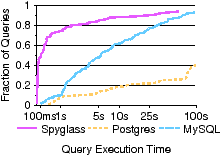
[Query set 2.
]
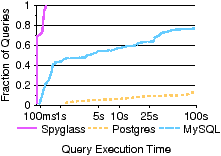
[Query set 3.
]
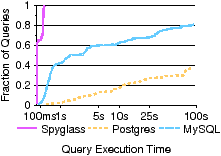
| Figure 11: Query execution times.
A CDF of query set execution times for the Eng trace. In Figures 11(b) and 11(c),
all queries are extremely fast because these sets include a
path predicate that allows Spyglass to narrow the search to a few
partitions. |
Index Locality. We now evaluate how well Spyglass exploits spatial locality to improve query performance. We generated
another set of queries, based on query 1 from
Table 5, with 500 queries with owner and ext values randomly selected from our Eng trace. We generated
similar query sets for individual ext and owner attributes.
[CDF of sub-tree partition accesses.]
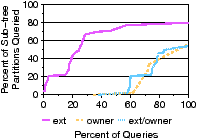
[CDF of partition cache hits.]
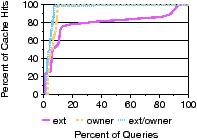
| Figure 12: Index locality. A CDF of the number of
partitions accessed and the number of accesses that were cache
hits for our query set. Searching multiple attributes reduces the
number of partition accesses and increases cache hits. |
Figure 12(a) shows a CDF of the fraction of partitions
searched. Searching more partitions often increases the amount of data
that must be read from disk, which decreases performance. We see that
50% of searches using just the ext attribute reference fewer than
75% of partitions. However, 50% of searches using both ext and
owner together reference fewer than 2% of the partitions, since
searching more attributes increases the locality of the search,
thereby reducing the number of partitions that must be searched.
Figure 12(b) shows a CDF of cache hit percentages for
the same set of queries. Higher cache hit percentages means that fewer
partitions are read from disk. Searching owner and ext attributes
together results in 95% of queries having a cache hit percentage of
95% or better due to the higher locality exhibited by multi-attribute
searches. The higher locality causes repeated searches in the
sub-trees where these files reside and allows Spyglass to ignore more
non-relevant partitions.
| Figure 13: Versioning overhead. The figure on the left
shows total run time for a set of 450 queries. Each version adds
about 10% overhead. On the right, a CDF shows per-query overheads.
Over 50% of queries have an overhead of 5 ms or less. |
Versioning Overhead. To measure the search
overhead added by partition versioning, we generated 450 queries based
on query 1 from Table 5 with values randomly
selected from our Web trace. We included three full days of
incremental metadata changes, and used them to perform three
incremental index updates. Figure 13 shows the
time required to run our query set with an increasing number of
versions; each version adds about a 10% overhead to the total run
time. However, the overhead added to most queries is quite small.
Figure 13 also shows, via a CDF of the query
overheads incurred for each version, that more than 50% of the
queries have less than a 5 ms overhead. Thus, it is a few much
slower queries that contribute to most of the 10% overhead. This
behavior occurs because overhead is typically incurred when
incremental indexes are read from disk, which doesn’t occur once a
partition is cached. Since reading extra versions does not
typically incur extra disk seeks, the overhead for the slower
queries is mostly due to reading partitions with much larger
incremental indexes from disk.
5 Related Work
Spyglass seeks to improve how file systems manage growing volumes of
data, which has been an important challenge and an active area of
research for over two decades. A significant amount of work has looked
at how file systems can improve file naming and organization by
leveraging file attributes. The Semantic File
System [16] utilized file ⟨
attribute,value ⟩ pairs to dynamically
construct a namespace based on queries rather than use a standard
hierarchical namespace. Virtual directories allowed queries to be
integrated directly into the namespace as a directory containing
search results. The Hierarchy and Content (HAC) [18]
file system looked as how Semantic File System concepts could be
applied to a hierarchical namespace, providing users with a new naming
mechanism without requiring them to forgo traditional hierarchies.
These and similar systems [32, 36]
focus on how users name and view files, though they do not focus on how
files are actually indexed and searched, thereby potentially limiting
their performance and scalability. While Spyglass does not provide
higher level naming semantics, it is the first to address the
challenge of scalable file metadata indexing and search, allowing it
to potentially be used as the underlying indexing method for such file
systems.
Spyglass focuses on how to exploit file metadata properties to
improve search performance and scalability, though it is not the first
to look at how new indexing structures improve file
retrieval. Inversion [33] used a general-purpose
DBMS as the core file system structure, rather than traditional file
system inode and data layouts. Inversion used several PostgreSQL
tables to store both file metadata and data, allowing the file system
to benefit from database transaction and recovery support and allowing
metadata and data to be queried. Like Spyglass, Inversion provides
ad hoc metadata query functionality, though it focuses on
allowing file systems to leverage database functionality rather than
on query performance.
However, a number of new index designs have been proposed to improve
various aspects of file system search.
GLIMPSE [29] reduced disk space requirements,
compared to a normal full-text inverted index, by maintaining only a
partial inverted index that does not store the location of every term
occurrence. Like Spyglass, GLIMPSE partitioned the search space,
using fixed size blocks of the file space, which were then referenced
by the partial inverted index. A tool similar to grep was
used to find exact term locations with each fixed size
block. Similarly, Diamond [20] eliminated disk space
requirements by using a mechanism to improve the speed of brute force
searches instead of maintaining an index. A technique called Early
Discard allowed files that are irrelevant to the search to be rejected
as early as possible, helping to reduce the search space. Early
Discard used application-specific “searchlets” to determine when a
file is irrelevant to a given query. Geometric
partitioning [24] aimed to improve inverted index
update performance by breaking up the inverted index’s inverted lists
by update time. The most recently updated inverted lists were kept
small and sequential, allowing future updates to be applied quickly. A
merging algorithm created new partitions as the lists grow over time.
Query-based partitioning [31] used a similar
approach, though it partitioned the inverted index based on file
search frequency, allowing index data for infrequently searched files
to be offloaded to second-tier storage to improve cost.
6 Conclusions and Future Work
As storage systems have become larger, finding and managing files has
become increasingly difficult. To address this problem we presented
Spyglass, a metadata search system that improves file management by
allowing complex, ad hoc queries over file metadata. Spyglass introduces several novel indexing techniques that improve metadata
crawling, search, and update performance by exploiting metadata
properties. Our evaluation shows that Spyglass has up to 1–4 orders
of magnitude faster search performance then existing designs.
We plan on improving Spyglass in the future in a number of ways.
First, we plan on addressing file security by leveraging hierarchical
partitioning to help eliminate partitions that the user does not have
access to from the search space. Second, we are exploring new
interface and query language designs that allow users to ask complex
queries (e.g., “back-in-time” queries) while remaining easy to
use. Third, we propose fully distributing Spyglass across a cluster
by allowing partitions to be replicated and migrated across
machines. Fourth, we will explore how partitioning can be improved by
using other metadata attributes to partition the index. Finally, we
are looking at how Spyglass can be used as the main metadata store
for a storage system, eliminating many of the space and performance
overheads incurred when used in addition to the storage system’s
metadata store.
Acknowledgments
We would like to thank our colleagues in the Storage Systems Research
Center and NetApp’s Advanced Technology Group for their input and
guidance. Also, we thank Remzi Arpaci-Dusseau, Stavros Harizopoulos,
and Jiri Schindler for their early feedback and discussions on this
work. Finally, we would like to thank our shepherd Sameer Ajmani and
all of our anonymous reviewers, whose comments significantly improved
the quality of this paper.
This work was supported in part by the Department of Energy's
Petascale Data Storage Institute under award DE-FC02-06ER25768 and by
the National Science Foundation under award CCF-0621463. We
thank the industrial affiliates of the SSRC for their support.
References
-
[1]
-
D. J. Abadi, S. R. Madden, and N. Hachem.
Column-Stores vs. Row-Stores: How different are they really?
In SIGMOD 2008.
- [2]
-
N. Agrawal, W. J. Bolosky, J. R. Douceur, and J. R. Lorch.
A five-year study of file-system metadata.
In FAST 2007.
- [3]
-
S. Ames, C. Maltzahn, and E. L. Miller.
QUASAR: Interaction with file systems using a query and naming
language.
Technical Report UCSC-SSRC-08-03, University of California, Santa
Cruz, September 2008.
- [4]
-
Apple.
Spotlight Server: Stop searching, start finding.
https://www.apple.com/server/macosx/features/spotlight/, 2008.
- [5]
-
S. M. Beitzel, E. C. Jensen, A. Chowdhury, D. Grossman, and O. Frieder.
Hourly analysis of a very large topical categorized web query log.
In SIGIR 2004.
- [6]
-
M. A. Bender, M. Farach-Colton, J. T. Fineman, Y. R. Fogel, B. C. Kuszmaul, and
J. Nelson.
Cache-oblivious streaming B-trees.
In Proceedings of the 19th Symposium on Parallel Algorithms and
Architectures (SPAA ’07), pages 81–92, 2007.
- [7]
-
J. L. Bentley.
Multidimensional binary search trees used for associative searching.
Communications of the ACM, 18(9):509–517, 1975.
- [8]
-
B. H. Bloom.
Space/time trade-offs in hash coding with allowable errors.
Communications of the ACM, 13(7):422–426, 1970.
- [9]
-
E. Brewer.
Readings in Database Systems, chapter Combining Systems and
Databases: A Search Engine Retrospective.
MIT Press, 4th edition, 2005.
- [10]
-
S. Buttcher and C. L. Clarke.
A security model for full-text file system search in multi-user
environments.
In FAST 2004.
- [11]
-
J. R. Douceur and W. J. Bolosky.
A large-scale study of file-system contents.
In SIGMETRICS 1999.
- [12]
-
Enterprise Strategy Groups.
ESG Research Report: storage resource management market on the launch pad,
2007.
- [13]
-
C. Faloutsos and S. Christodoulakis.
Signature files: An access method for documents and its analytical
performance evaluation.
ACM ToIS, 2(4), 1984.
- [14]
-
Fast, A Microsoft Subsidiary.
FAST – enterprise search.
https://www.fastsearch.com/, 2008.
- [15]
-
G. R. Ganger and M. F. Kaashoek.
Embedded inodes and explicit groupings: Exploiting disk bandwidth for
small files.
In USENIX 1997.
- [16]
-
D. K. Gifford, P. Jouvelot, M. A. Sheldon, and J. W. O’Toole, Jr.
Semantic file systems.
In SOSP 1991.
- [17]
-
Google, Inc.
Google enterprise.
https://www.google.com/enterprise/, 2008.
- [18]
-
B. Gopal and U. Manber.
Integrating content-based access mechanisms with hierarchical file
systems.
In OSDI 1999.
- [19]
-
D. Hitz, J. Lau, and M. Malcom.
File system design for an NFS file server appliance.
In USENIX Winter 1994.
- [20]
-
L. Huston, R. Sukthankar, R. Wickremesinghe, M. Satyanarayanan, G. R. Ganger,
E. Riedel, and A. Ailamaki.
Diamond: A storage architecture for early discard in interactive
search.
In FAST 2004.
- [21]
-
Kazeon.
Kazeon: Search the enterprise.
https://www.kazeon.com/, 2008.
- [22]
-
Kernel.org.
inotify official readme.
https://www.kernel.org/pub/linux/kernel/people/rml/inotify/README, 2008.
- [23]
-
S. Khoshafian, G. Copeland, T. Jagodits, H. Boral, and P. Valduriez.
A query processing strategy for the decomposed storage model.
In ICDE 1987.
- [24]
-
N. Lester, A. Moffat, and J. Zobel.
Fast on-line index construction by geometric partitioning.
In CIKM 2005.
- [25]
-
A. W. Leung, S. Pasupathy, G. Goodson, and E. L. Miller.
Measurement and analysis of large-scale network file system
workloads.
In USENIX 2008.
- [26]
-
A. W. Leung, M. Shao, T. Bisson, S. Pasupathy, and E. L. Miller.
High-performance metadata indexing and search in petascale data
storage systems.
Journal of Physics: Conference Series, 125, 2008.
- [27]
-
libkdtree++.
https://libkdtree.alioth.debian.org/, 2008.
- [28]
-
C. A. Lynch.
Selectivity estimation and query optimization in large databases with
highly skewed distribution of column values.
In VLDB 1988.
- [29]
-
U. Manber and S. Wu.
GLIMPSE: A tool to search through entire file systems.
In USENIX Winter 1994.
- [30]
-
Microsoft, Inc.
Enterprise search from microsoft.
https://www.microsoft.com/Enterprisesearch/, 2008.
- [31]
-
S. Mitra, M. Winslett, and W. W. Hsu.
Query-based partitioning of documents and indexes for information
lifecycle management.
In SIGMOD 2008.
- [32]
-
K.-K. Muniswamy-Reddy, D. A. Holland, U. Braun, and M. Seltzer.
Provenance-aware storage systems.
In USENIX 2006.
- [33]
-
M. A. Olson.
The design and implementation of the Inversion file system.
In USENIX Winter 1993.
- [34]
-
Oracle.
Oracle berkeley db.
https://www.oracle.com/technology/products/berkeley-db/index.html, 2008.
- [35]
-
J. K. Ousterhout, A. R. Cherenson, F. Douglis, M. N. Nelson, and B. B. Welch.
The Sprite network operating system.
IEEE Computer, 21(2):23–36, Feb. 1988.
- [36]
-
Y. Padioleau and O. Ridoux.
A logic file system.
In USENIX 2003.
- [37]
-
Private Customers.
On the efficiency of modern metadata search appliances, 2008.
- [38]
-
J. T. Robinson.
The K-D-B-tree: a search structure for large multidimensional
dynamic indexes.
In SIGMOD 1981.
- [39]
-
D. S. Santry, M. J. Feeley, N. C. Hutchinson, A. C. Veitch, R. W. Carton, and
J. Ofir.
Deciding when to forget in the Elephant file system.
In SOSP 1999.
- [40]
-
H. A. Simon.
On a class of skew distribution functions.
Biometrika, 42:425–440, 1955.
- [41]
-
C. A. N. Soules, G. R. Goodson, J. D. Strunk, and G. R. Ganger.
Metadata efficiency in versioning file systems.
In FAST 2003.
- [42]
-
M. Stonebraker and U. Cetintemel.
"One Size Fits All": An idea whose time has come and gone.
In ICDE 2005).
- [43]
-
M. Stonebraker, S. Madden, D. Abadi, S. Harizopoulos, N. Hachem, and
P. Helland.
The end of an architectural era (it’s time for a complete rewrite).
In VLDB 2007.
- [44]
-
S. A. Weil, S. A. Brandt, E. L. Miller, D. D. E. Long, and C. Maltzahn.
Ceph: A scalable, high-performance distributed file system.
In OSDI 2006.
- [45]
-
K. Wu, E. Otoo, and A. Shoshani.
Optimizing bitmap indices with efficient compression.
ACM ToDS, 31(1), 2006.
This document was translated from LATEX by
HEVEA.
 [Locality Ratio=38%]
[Locality Ratio=38%]


 []
[]
 []
[]

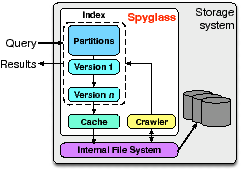
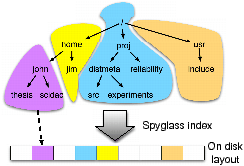
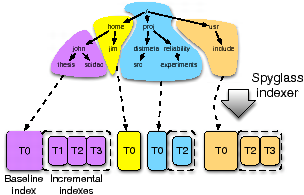
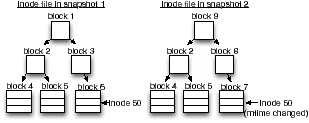
 [Incremental: 2%, 5%, and 10% changes from baseline]
[Incremental: 2%, 5%, and 10% changes from baseline]

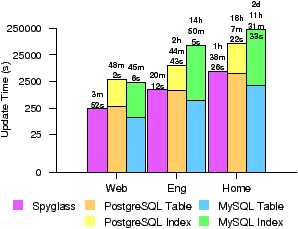
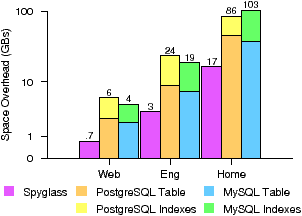

 [Query set 2.
[Query set 2.
 [Query set 3.
[Query set 3.

 [CDF of partition cache hits.]
[CDF of partition cache hits.]

